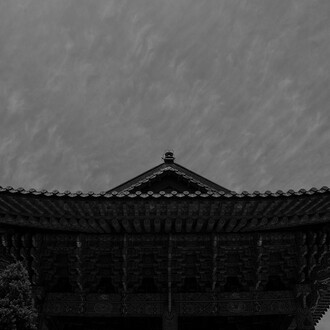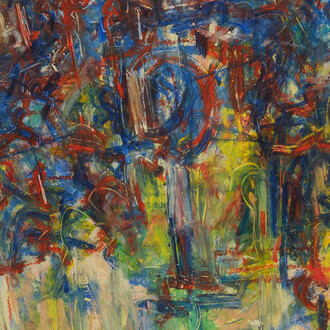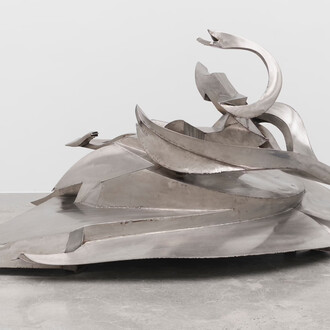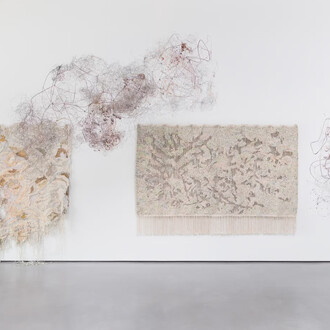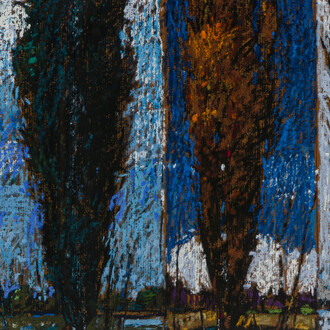The Bronx Museum of the Arts and Visual AIDS are pleased to present Ministry: Reverend Joyce McDonald, the first institutional exhibition devoted to the work of the New York artist, who crafts moving testimonies to themes that have shaped her life: hope, grace, and serenity, as well as hardship, loss, and devotion. On view from September 5, 2025 to January 4, 2026, the exhibition is curated by Kyle Croft, Executive Director of Visual AIDS, and surveys the artist’s prolific sculptural output since the 1990s, bringing together early works in air-dry clay and found materials with recent glazed ceramics.
Ordained as a minister at the Church of the Open Door in 2009, McDonald uses her own struggles to drive her work as an artist, activist, advocate, and “spiritual nurse.” She considers her art an extension of her ministry and a channel for divinity, compassion, and healing. A self-described “testimonial artist,” McDonald is open about sharing her story, including a long battle with addiction and an HIV diagnosis in 1985—and uses her artwork to inspire confidence and dignity in others.
Eileen Jeng Lynch, Director of Curatorial Programs at The Bronx Museum, comments: “Reverend Joyce McDonald’s work as an artist, activist, and healer perfectly embodies The Bronx Museum’s commitment to serving our communities and championing artists who have been systemically marginalized, following seminal exhibitions by artists such as Alvin Baltrop, whose iconic photographs memorialized the underground gay culture of NYC’s West Side piers throughout the 1970s; Martin Wong, a key figure and documentarian of the city’s Lower East Side at the height of the AIDS crisis; and more recently, the first survey exhibition of Darrel Ellis, foregrounding his experimental photographic style and vision to redefine Black male identity. Our curatorial program aims to resonate with the lived experiences of people who call this city home, and to engage the Museum as a platform for artistic empowerment. We are delighted to continue in this vein by presenting the first institutional survey of McDonald’s beautiful and sensitive work.”
Over the past four decades, McDonald has produced a vast body of intimately scaled handformed ceramic sculptures, often depicting figures in repose or embrace that embody the strength, support, and unconditional love that has sustained her life. Religious scenes also recur throughout McDonald’s oeuvre, including mothers with children, such as Covered with love (2003) and Safe in his arms (2021); individuals in devotional poses like In comforting delight (Self-portrait) (1998) and The family that pray (2001); and others adorned with robes or shrouds, like Sweet peace (2007). Working intuitively, McDonald’s sculptural practice also frequently depicts family members and reflects current events. In the series Our lives mattered (2020), McDonald honors the lives of those lost to racially motivated police violence including George Floyd and Breonna Taylor.
Though artistically inclined as a child, it was not until the late 1990s that McDonald began sculpting with clay at a day treatment program for people living with HIV, finding respite in the creative practice. Her art therapist soon introduced her to Visual AIDS, an organization committed to supporting artists living with HIV and preserving the work of those lost to AIDS. McDonald has been an integral part of the organization’s identity for nearly three decades, participating in numerous group exhibitions and events. The artist has also displayed her sculptures at churches and community centers to share her story and help inspire others to get in touch with their inner beauty and dignity.
“In addition to presenting McDonald’s unique vision, Ministry aims to correct the sometimes reductive summaries that foreground her hardships or frame her as an outsider artist,” comments Kyle Croft, Executive Director of Visual AIDS. “Like many Visual AIDS artist members, Joyce McDonald has created and presented her work on her own terms for decades. As we work to rethink and expand cultural narratives of AIDS, this exhibition is particularly meaningful: Ministry is not only the first institutional survey of McDonald’s work but also the first solo artist exhibition Visual AIDS has organized in collaboration with a museum.”
A robust 120-page catalog to accompany the exhibition will be published in September 2025 by Visual AIDS and The Bronx Museum. Essays by Croft and Dr. Jareh Das, curator of Body vessel clay: black women, ceramics and contemporary art, will provide some of the first critical writing about McDonald’s sculpture, while an interview with the artist will center her voice. Ministry will also feature free community-engaged programming inspired by the exhibition, including art-making activities for all ages and interactive tours.
In addition to her creative pursuits, McDonald is also an advocate and activist for the most vulnerable members of society. Her work includes founding an HIV awareness and creative arts group for young girls and teens, working with women in shelters and hospitals, writing letters to incarcerated women, coordinating her church’s AIDS ministry, and serving as assistant director of its children’s choir.
McDonald grew up in a creative family: her father was an accomplished photographer, her sister is a celebrated novelist, and as a teenager, McDonald performed at the Apollo Theater in a girl’s group called The Primettes. The Bronx Museum exhibition includes a selection of ephemera, archival materials, and family photographs that illuminate McDonald’s remarkable journey as an artist. Alongside photographs that depict her sculptures displayed in various social contexts are those taken by her father of the Farragut Houses in Brooklyn, where McDonald was born.










